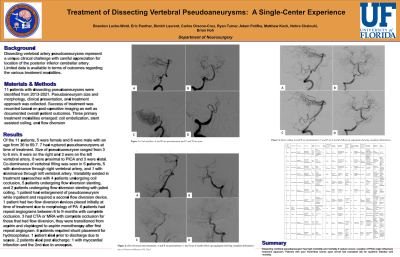Treatment of Vertebral Artery Dissecting Pseudoaneurysms
Friday, April 21, 2023


Brandon P. Lucke-Wold, MD, PhD
Resident
University of Florida
Gainesville, Florida, United States
ePoster Presenter(s)
Introduction: Dissecting vertebral artery pseudoaneurysms represent a unique clinical challenge with careful appreciation for location of the posterior inferior cerebellar artery.
Methods: 11 patients with dissecting pseudoaneurysms were identified from 2013-2021. Pseudoaneurysm size and morphology, clinical presentation, and treatment approach was collected. Success of treatment was recorded based on post-operative imaging as well as documented overall patient outcomes. Three primary treatment modalities emerged: coil embolization, stent assisted coiling, and flow diversion.
Results: Of the 11 patients, 5 were female and 6 were male with an age from 36 to 69.7. 7 had ruptured pseudoaneurysms at time of treatment. Size of pseudoaneurysm ranged from 3 to 6 mm. 8 were on the right and 3 were on the left vertebral artery. 8 were proximal to PICA and 3 were distal. Co-dominant vertebral filling was seen in 5 patients, 5 with dominant right vertebral artery, and 1 with dominant left vertebral artery. Variability existed in treatment approaches with 4 patients undergoing coil occlusion, 5 patients undergoing flow diversion, and 2 patients undergoing flow diversion stenting with jailed coiling. 1 patient had enlargement of pseudoaneurysm while inpatient and required a second flow diversion device. 1 patient had two flow diversion devices placed initially at time of treatment due to morphology of PA. 6 patients had repeat angiograms between 6 to 9 months with complete occlusion. 3 had CTA or MRA with complete occlusion for those that had flow diversion, they were transitioned from aspirin and clopidogrel to aspirin monotherapy after first repeat angiogram. 6 patients required shunt placement for hydrocephalus. 1 patient died prior to discharge due to sepsis. 2 patients died post discharge: 1 with myocardial infarction and the 2nd due to urosepsis.
Conclusion : Location of PICA origin influences treatment approach. Patients with poor Hunt/Hess scores upon arrival had increased risk for systemic infection and mortality.
Methods: 11 patients with dissecting pseudoaneurysms were identified from 2013-2021. Pseudoaneurysm size and morphology, clinical presentation, and treatment approach was collected. Success of treatment was recorded based on post-operative imaging as well as documented overall patient outcomes. Three primary treatment modalities emerged: coil embolization, stent assisted coiling, and flow diversion.
Results: Of the 11 patients, 5 were female and 6 were male with an age from 36 to 69.7. 7 had ruptured pseudoaneurysms at time of treatment. Size of pseudoaneurysm ranged from 3 to 6 mm. 8 were on the right and 3 were on the left vertebral artery. 8 were proximal to PICA and 3 were distal. Co-dominant vertebral filling was seen in 5 patients, 5 with dominant right vertebral artery, and 1 with dominant left vertebral artery. Variability existed in treatment approaches with 4 patients undergoing coil occlusion, 5 patients undergoing flow diversion, and 2 patients undergoing flow diversion stenting with jailed coiling. 1 patient had enlargement of pseudoaneurysm while inpatient and required a second flow diversion device. 1 patient had two flow diversion devices placed initially at time of treatment due to morphology of PA. 6 patients had repeat angiograms between 6 to 9 months with complete occlusion. 3 had CTA or MRA with complete occlusion for those that had flow diversion, they were transitioned from aspirin and clopidogrel to aspirin monotherapy after first repeat angiogram. 6 patients required shunt placement for hydrocephalus. 1 patient died prior to discharge due to sepsis. 2 patients died post discharge: 1 with myocardial infarction and the 2nd due to urosepsis.
Conclusion : Location of PICA origin influences treatment approach. Patients with poor Hunt/Hess scores upon arrival had increased risk for systemic infection and mortality.
